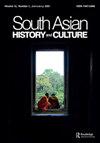Om Puri in/and 1980s Hindi cinema: narrating the ‘nation’ and the ‘subaltern protagonist’
IF 0.3
0 ASIAN STUDIES
引用次数: 0
Abstract
ABSTRACT This article focuses on analysing the 1980s Hindi cinema through Om Puri’s (1950–2017) text. Much awarded, feted and internationally known for acting in Hollywood and British productions, Puri’s text needs to be mapped critically. If Bachchan’s star text has acquired a metonymic status typifying the 1970s, then the 1980s can be termed as the Om Puri decade as his cinematic text navigated across New Wave films housing the politics and praxis of the ‘subaltern peasant body’, inhabiting the disenchantment of the times in films such as Aarohan, Ardh Satya, Aakrosh, Susman, Mirch Masala, etc. This article analyses Aakrosh (1980) and Aarohan (1982) and his biography, Unlikely Hero (2009), and attempts to uncover the nodes of Puri’s actor/star text as a crucial site for excavating the much-neglected history of the subaltern male actor/subaltern-citizen in the New Wave Hindi cinema of the 1980s. The critical questions for the article are: Can one move away from the towering Bachchan phenomena and chart out a different trajectory of the male actor for the Hindi film hero/protagonist? How can one locate the emergence of this male actor with a different idiom of masculinity that typifies the 1980s Hindi cinema, borrowing Peberdy’s argument on masculine performative angst in American films of the 1990s? Can Puri’s text that navigated the parallel and the popular be used to map the emergence of another node of the actor/star such as Nawazuddin Siddiqui for the contemporary Hindi cinema?20世纪80年代印度电影中的奥姆·普里:讲述“国家”和“次等主角”
本文主要通过Om Puri(1950-2017)的文本分析20世纪80年代的印度电影。普里因在好莱坞和英国作品中的表演而备受赞誉,并在国际上享有盛誉,他的作品需要被批判性地描绘出来。如果巴克尚的明星文本已经获得了一种代表20世纪70年代的转义地位,那么20世纪80年代可以被称为奥姆普里的十年,因为他的电影文本穿越了新浪潮电影,其中包含了“下层农民身体”的政治和实践,居住在时代的幻灭电影中,如阿罗汗,阿德·萨蒂亚,阿克罗什,苏斯曼,米尔奇·马萨拉等。本文分析了Aakrosh(1980)和Aarohan(1982)以及他的传记《不可能的英雄》(2009),并试图揭示Puri的演员/明星文本的节点,作为挖掘20世纪80年代新浪潮印度电影中被忽视的底层男性演员/二等公民历史的关键地点。这篇文章的关键问题是:人们能否从高耸的巴克坎现象中解脱出来,为印度电影的男主角描绘出一条不同的轨迹?借用佩伯迪对20世纪90年代美国电影中男性表现焦虑的论述,我们如何将这位男演员的出现与20世纪80年代印度电影中典型的男性气质的不同成语联系起来?普里的文字在平行和流行之间进行了导航,可以用来描绘演员/明星的另一个节点的出现,比如纳瓦祖丁·西迪基对当代印度电影的影响吗?
本文章由计算机程序翻译,如有差异,请以英文原文为准。
求助全文
约1分钟内获得全文
求助全文

 求助内容:
求助内容: 应助结果提醒方式:
应助结果提醒方式:


